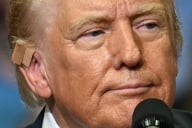You have /5 articles left.
Sign up for a free account or log in.
Almost all colleges reflect the breadth of political opinion of the country as a whole, although not in the same proportion. While most are more liberal than their surrounding communities, they are far from politically homogeneous. For that reason, we as presidents have to be careful in how we present our personal political views.
To be sure, just as for the average citizen, we enjoy the right and privilege, under our Constitution, to speak our minds on any subject we wish. But with that freedom comes the responsibility to recognize that, however much we may want to speak only for ourselves, we nevertheless do so with the title “President” in front of our names -- which means our comments will be linked to our campus.
Most of us see ourselves as stewards of a sacred trust, upholding the traditional values of higher education -- which includes protecting every person on our campus from discrimination and arbitrary abrogation of rights and privileges. Understandably, we may meet threats to abridge such rights, even from the nation’s president in the absence of a clear and present showing of need, with reactions ranging from skepticism to studied opposition to outright rejection. For the most part, however, we should put our emotions aside and carefully consider how we should be reacting, especially in today’s divisive and rancorous political environment.
How should college presidents balance their personal views with the need to model best practices for our students?
Consider three recent events.
First, President Trump’s executive order that suspended travel of nationals of seven Muslim-majority nations. College presidents immediately responded. Many focused on reassuring the students and faculty members who were the targets of the executive order that they would be supported and protected by the campus to the best of its ability. My response was in that category: a statement of reassurance to the Roger Williams University campus that our commitment to religious freedom -- the hallmark of our namesake -- would be unflagging. I deliberately chose not to characterize the executive order itself.
But quite a few presidential comments were directed at the executive order, and, by extension, Trump, who, of course, promulgated it. Some presidents used particularly strong language: Brian Rosenberg, president of Macalester College in Minnesota, called the executive order “cowardly and cruel,” and he urged other college presidents to speak with “particular force” as they responded.
Second, the campus speaking tour of Milo Yiannopoulos, until recently an editor at the Breitbart alt-right news network. His remarks were so provocative that many of his appearances were picketed (University of Minnesota), interrupted (DePaul University), prematurely ended (University of California, Los Angeles), a cause of violence (University of Washington) or canceled (University of California, Berkeley). In the last situation, Nicholas Dirks, the Berkeley chancellor, explained his decision to cancel the Yiannopoulos speech in a letter to The New York Times, saying that he did so “reluctantly” and “only after determining that both the speaker’s and the public’s safety was highly endangered” -- citing concerns about “more than 100 armed people in masks and dark uniforms who used paramilitary tactics to engage in violent destructive behavior” coming from outside onto the campus. (Yiannopoulos, the Heritage Foundation and even Trump promptly issued news releases or tweets condemning the cancellation -- and Trump threatened to end all federal funding at Berkeley.)
Third, presidential counselor Kellyanne Conway’s contention that statements by Trump that the news media have determined to be false are “alternative facts.” Conway’s characterization has invoked strong reactions throughout the country. President Patricia McGuire of Trinity Washington University, for instance, publicly criticized in her president’s blog the part played by Conway, a Trinity alumna, in “facilitating the manipulation of facts” on behalf of Trump.
These three situations reflect different ways to deal with the emerging political agenda of the current administration. They also underscore the need for each of us as presidents to determine the approach that we think is best for our institution and our students.
For my part, I submit that this is a time to be moderate in our responses and to endeavor to create bridges across the widening chasm between liberals and conservatives, Democrats and Republicans. In fact, if we college presidents cannot play or are unwilling to play this role, I despair for the future of our country.
For example, I see no advantage for college presidents to respond to initiatives such as Trump’s executive order regarding refugees with language that has the result of raising the temperature around the issue at hand. Words like “cruel” and “cowardly” are not said with an eye toward promoting a civil conversation -- and someone has to commit to civility if we are to avoid even greater polarization in our nation. Unilateral declarations by college presidents do very little to prompt a fruitful debate, let alone to change the minds of those on the other side of the matter.
Similarly, in my view, while McGuire was correct to challenge Conway’s casual use of “alternative facts,” she erred when she moved from fact to opinion: stating that such use is evidence of “a thinly veiled autocratic scheme” and that Trump’s executive order amounts to a “cruel and unreasonable war on immigrants.” In response to those comments, she received accolades from the left and brickbats from the right, but she changed no one’s mind (read the 100 comments posted in response to an Inside Higher Ed article on the topic). In such cases, an opportunity to spark a civil discussion is often lost, elbowed aside by the use of needlessly inflammatory language.
There is a real danger should presidents, as leaders of our campuses, speak out in judgmental terms about the wisdom of an administrative action, because we will be seen as effectively endeavoring to end the debate before it begins. Rather than creating the opportunity for students individually to listen to two sides of a matter and come to their own individual conclusions, we will be seen as deciding for the students and presenting the answer as a foregone conclusion.
The current moment presents a wonderful opportunity for presidents both to encourage the discussion of vitally important issues with their students, and to do so in a manner that reflects the civility of discourse we both honor and endeavor to instill in our students while they are part of our campus communities. For example, the executive order on immigration and the canceled speech at Berkeley are the type of events that, if managed well by college presidents, can be consequential in rebuilding community, both on campuses and nationally.
In response to the executive order on immigration, statements of concern, a recommitment to core values and expressions of support for those imperiled are all expected and appropriate. One method of modeling best practices for our students -- and allowing them to see the democratic process in action -- would be to create forums on campuses to discuss whether the current level of protection of our citizens from terrorist attacks is sufficient, and if not, what additional steps might be considered, weighing the balance between the degree to which safety would be enhanced versus the degree to which particular actions might actually increase the level of danger.
Reclaiming the Middle Ground
At a national meeting of academics in January, a much-discussed topic was the question of how higher education should act to rebuild the public’s trust in the work of our sector. One way to start might be to recognize that most of America has not ceded to academics the right to decide unilaterally on the wisdom or folly of particular political actions -- and we should stop acting as if they have.
We should remember that, in the days following the issuance of the executive order, a slight plurality of the American public approved of the president’s action, even though a majority of campus presidents who took a position on the matter opposed Trump’s executive order.
Moreover, the movement away from civil conversation has strengthened the hands of those who oppose the very notion of civility. The deliberately provocative words of alt-right spokesmen such as Yiannopoulos and Richard Spencer are countered by the so-called black bloc -- the anarchists and anti-fascists who violently disrupted the scheduled Yiannopoulos speech at Berkeley. The alt-right movement provokes violent dissent, and the black bloc anarchists are only too happy to provide violent dissent. The alt-right then claims that government intervention is required to protect free speech, the anarchists celebrate the breakdown of civil order and universities become the unwitting foils in an attack on democratic principles.
If college campuses are being targeted as the battleground between extremists on the left and right, then college presidents have to find ways to reclaim the middle ground. This starts with conversations between the institution’s administration and campus political groups and the creation of forums for debate between representative voices from left and right. A true debate, where students are invited to witness a meaningful presentation of opposing views, is far more interesting and useful than one-sided diatribes.
And, ultimately, that begins with college presidents deciding to use controversial issues as learning moments for our students -- not soapboxes from which we can proclaim our personal opinions.








